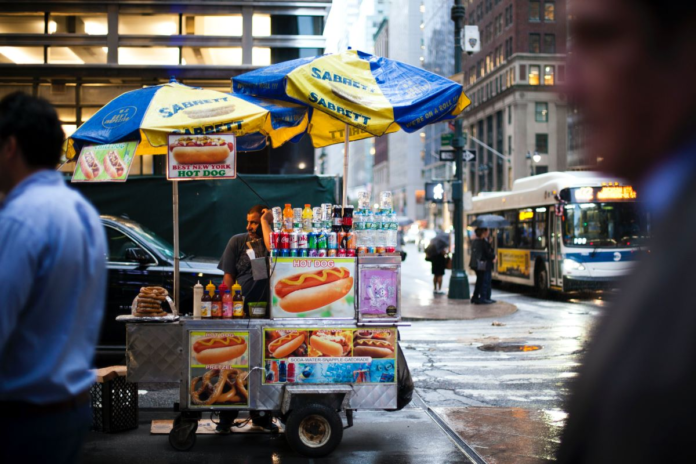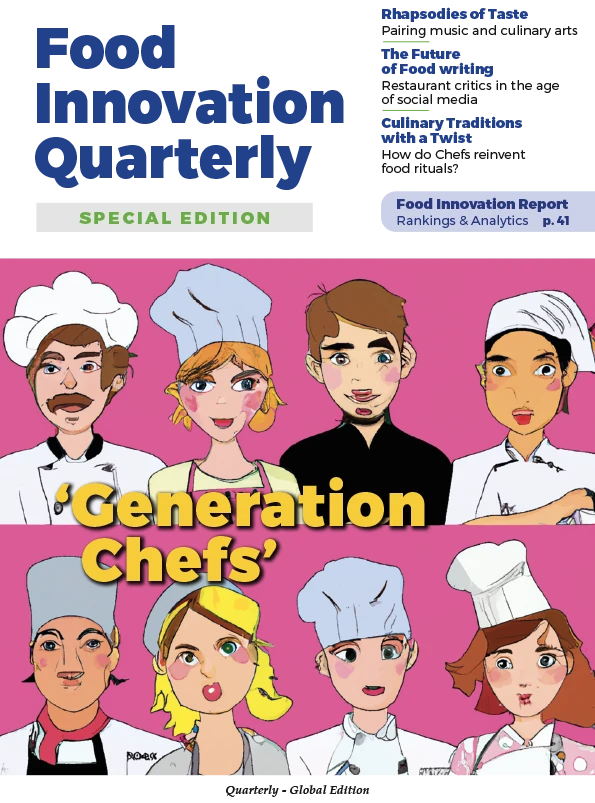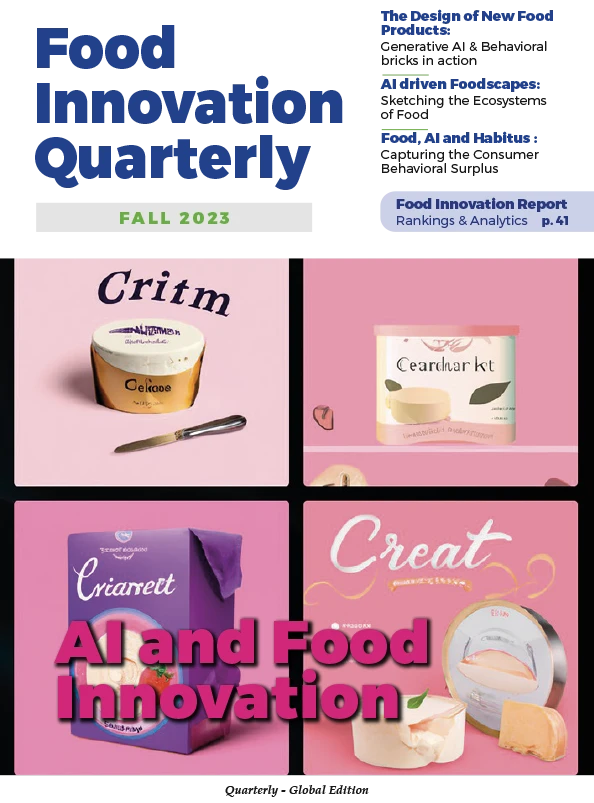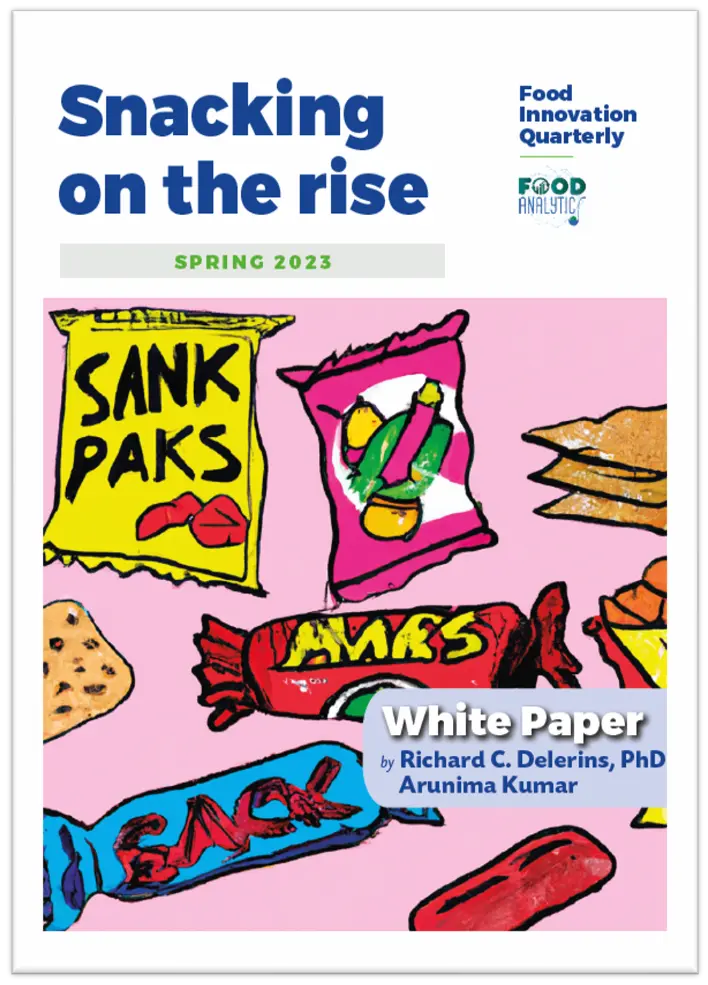Born in France to a French Argentinian mother and an American father, I grew up in NYC’s Upper West Side, a multi-cultural neighborhood that retained much of its historically Jewish demographic, and bordering on Harlem, which as of 2019 boasted 23,650 restaurants and bars.
Biting the Big Apple
But it wasn’t always so. At the end of the 1950s when my father returned to NYC from his Medical studies in Paris with his French Argentine wife, my mother was devastated to discover that, while a cultural cornucopia, New York was a huge culinary disappointment. The choice of restaurants was few, the limited world cuisines had mostly traded their authenticity to adapt to American palates. For someone accustomed to bustling street markets overflowing with fresh produce, and regular trips to the Fromagerie, boulangerie, patisserie and traiteur, NYC’s food offerings were bleak indeed.
NYC’s rich tapestry of tastes defies orderly organization, and so my reflections are through the lens of my experience as I witnessed the evolution, or perhaps transformation, of the city’s food landscape into the rich world of flavors, cross cultural influences, and innovations that this melting pot deserved. Growing up in the 1960s and 1970s there were a small number of nationalities, along with iconic NYC foods, which dominated my food world. So that is how I will share them.
To give some context it might be useful to take a brief look at the history of the city’s dining scene. In revolutionary NYC taverns (one for every forty-five residents) played an outsized role in society. As Michael and Ariane Batterberry point out in their seminal book, On the Town in New York, “It’s important to remember that Taverns were the local hotels, restaurants and meeting houses of the eighteenth Century,” where much of the fighting of the revolution was planned.
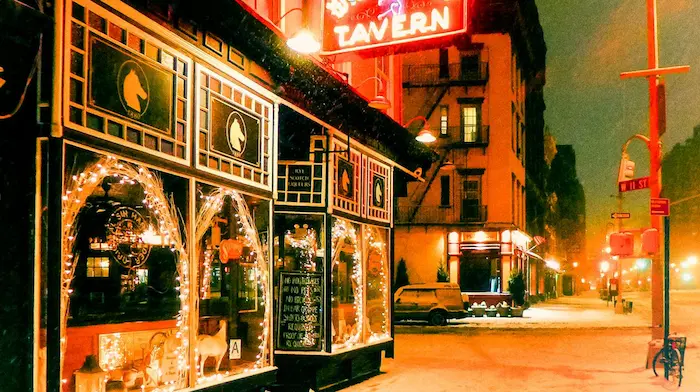
Fighting also took place inside the often-riotous taverns. New Yorkers sure liked to drink. Fortified wine, port, sherry, brandy, rum, local beer, imported ale and porter were popular. Drinking was only allowed at tables, not at the bar, which would have a mesh gate that could be pulled down to protect the bottles (and staff) when fights broke out. By contemporary standards, the food was not very appealing (dinner might be cold meat and an ale). “Variety and imagination were foreign to post-Revolutionary tavern kitchens,” according to the Batterberrys.
The Contemporary Gastro-tainment
The slow road to change may have begun after the British left in 1783, with entrepreneurs like Sam Fraunces, who was asked to organize the first public dinner for Washington. (Fraunces Tavern continues as the oldest pub restaurant in the NYC’s oldest standing structure). He would prove to be one of a small number of men who would alter the direction of dining in NYC.
An influx of French, many escaping the rages of the French revolution, brought with them a much-needed culinary influence and helped fuel a Francophilia that had positive impact on the city’s dining. Joseph Corré and Joseph Delacroix created competing Vauxhall gardens, inspired by the European Pleasure Gardens. These over-the-top venues combined food, drink, entertainment, fountains, romantic statuary, fireworks, live bands, flower gardens, and outdoor theater. In 1813 William Niblo, who created his world-famous Pleasure Garden, modeled on London’s Vauxhall, displayed an unparalleled sense of drama and showmanship, going to great lengths to dazzle guests. He was said to wheel an entire standing roast bear through the room for effect. It might be argued that these pleasure gardens were precursors to the contemporary “gastro-tainment” (reflected in theme restaurants, dinner theater, and open kitchens with counter service) which has consumed American dining tastes these two plus centuries later.
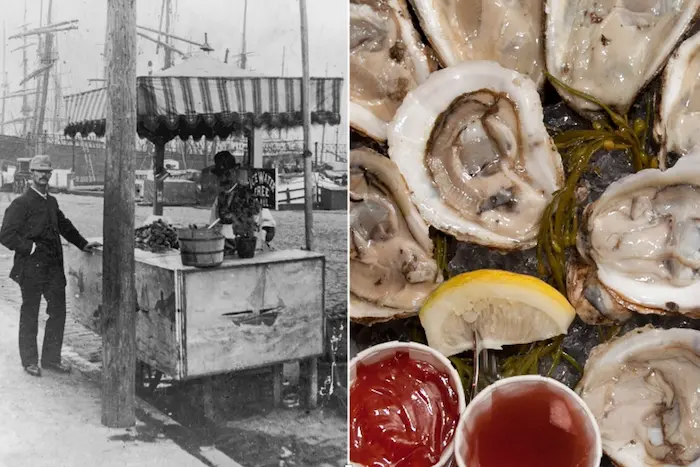
Around 1820, when the first real restaurants in NYC emerged, there were three types; the coffee house, the short-order house (a precursor to the Diner) and the French restaurant, which appealed more to women. NYC enjoyed an abundance of ingredients from the many farms and prosperous fishing and hunting. The high protein diet included beef, mutton, pork, venison, fowl, fish and Oysters. In fact, NYC was so famous for its Oysters that one might say it was (besides French wine country) the original food tourism destination. Food lovers traveled from as far as Europe to savor NYC’s famous Oysters. (So much so, that the oyster beds were quickly depleted, and to this day Canada is the primary purveyor of the City’s Oysters.)
Childhood Menu Memories
My food fixation may have begun with chocolate, which consumed most of my weekly allowance money as child in 1960s NYC, when Hershey’s and Nestlé’s were the chocolate benchmarks. Gourmet chocolate would not be readily available in NYC for several decades, but my mother, who sorely missed the fine foods so accessible in Europe, had scouted out a few foodie finds in our Upper West Side Neighborhood. About once a week we would walk the block to Broadway where a sliver of a shop, run by two European WWII survivors, was crammed with hard-to-find sweets. A Lindt chocolate bar, as rare and as prized as a gold bar, became my new gold standard for chocolate. (The discovery of European chocolate may have kindled the passion that led me to help launch the first Salon du Chocolat in American in 1998.) Our go-to gourmet candy shop has long been consumed by NYC’s insatiable hunger to develop and build.
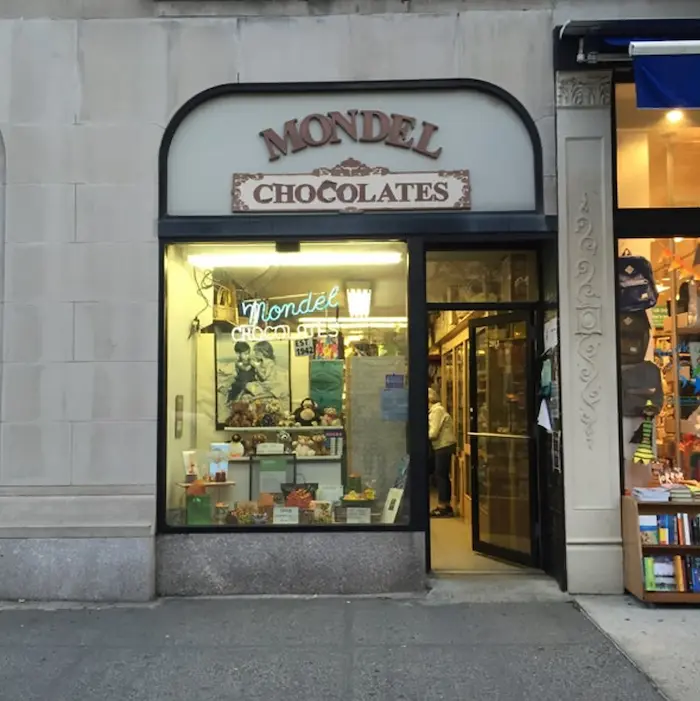
Luckily Mondel’s Chocolates, favored by Kathrine Hepburn and Humphrey Bogart, and in the same spirit of my childhood shop, is still operating since 1943. While the tireless pace of change may give NYC an exciting frisson, it also threatens to rob it of a true sense of, or rather taste of, place.
One of the things that really rang my bell as a NYC kid was the chocolate covered ice cream bars from the Good Humor truck, whose tinkling bell announcing its arrival was the only thing that could pull me away from the revelry of the Riverside Park playground. Pavlov needn’t have bothered with his dogs if he had any idea of NYC children’s boundless reverence for the man in the white jacket who handed out happiness in the form of frozen treats. I am glad to report that NYC has preserved this simple pleasure, and in addition to the iconic Good Humor truck and carts, a new generation of artisanal foody purveyors, like Brooklyn founded Van Leeuwen’s Ice Cream, have driven the concept of the ice cream truck into the 21st Century.
Chinese: Commensality & Keeping it Kosher
Occasionally, when one of my parents would declare, “let’s go out for dinner,” my siblings and I understood that to mean The Hunan Balcony, the Chinese restaurant down the block, Until I was about twelve, I would embarrass my family by usually barking out my order for a decidedly un-Asian “club sandwich, hold the Mayo.” But I soon grew to appreciate and relish the NYC Chinese delicacies. Chicken Fried Rice, Beef and Broccoli, General Tsao’s Chicken, and Egg Rolls were our default dishes.
As a child, dinner out at the Chinese restaurant was always special; the exotic tastes, being served, eating with the grown-ups. What I didn’t fully appreciate at the time was how sharing dishes, one of the wonderful cultural hallmarks of the Chinese meal, created a particularly powerful sense of commensality, the act of eating together and the exchange that promotes.
Chinese restaurants have long been a leading choice for New York Jewish families for generations. For insight as to why that is, I asked restaurant consultant Michael Whiteman, co-creator of world-famous restaurants including Windows on the World which was atop the Twin Towers. Whiteman pointed out that the affinity for Chinese food among NYC Jewish community has very practical and longstanding roots. “The two ethnic groups lived close to each other on the Lower East Side, which is where our grandparents or great-grandparents first lived, and the adjacent Chinatown.”
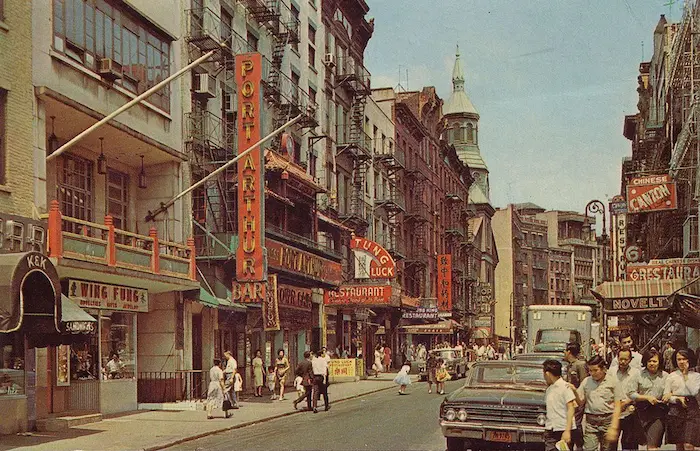
He also believes that “Jews gravitated to Chinese restaurants because, both being minorities, Jews felt safe there knowing that they wouldn’t be discriminated against — which often was the case with German and Italian restaurants.” (I remember my father telling us about the very overt Nazi sentiments he experienced at restaurants just blocks from his childhood NYC home, in a neighborhood known as Little Berlin.)
Whiteman also pointed out another very pragmatic reason was that Chinese restaurants were among the few that were open on Christian holidays. Also, since Chinese food has almost no dairy Jews who kept kosher did not have to worry about mixing meat and dairy. Chinese cuisine has managed to maintain its position as the most popular ethnic cuisine in NYC (and the US at large) ever since it knocked Italian out of the top spot over the past half century.
Slice Of Italy
New York of course boasts Little Italy, a neighborhood which has long been a dining destination in Manhattan’s Lower East Side (LES). But closer to home on the Upper West Side (UWS), when my older brother and I were of age to come home from school on our own, we discovered the true joys of a slice of NYC Pizza with a regular pitstop at Sal and Carmine’s Pizza shop. I would later continue the ritual when I accompanied my younger sister home, and decades later, with my young daughter. With just the right amount of crunch, generous amount of tomato sauce, and a crust browned to perfection, this unassuming small Pizza joint boasts accolades from the likes of the New York Times on the white tiled walls.
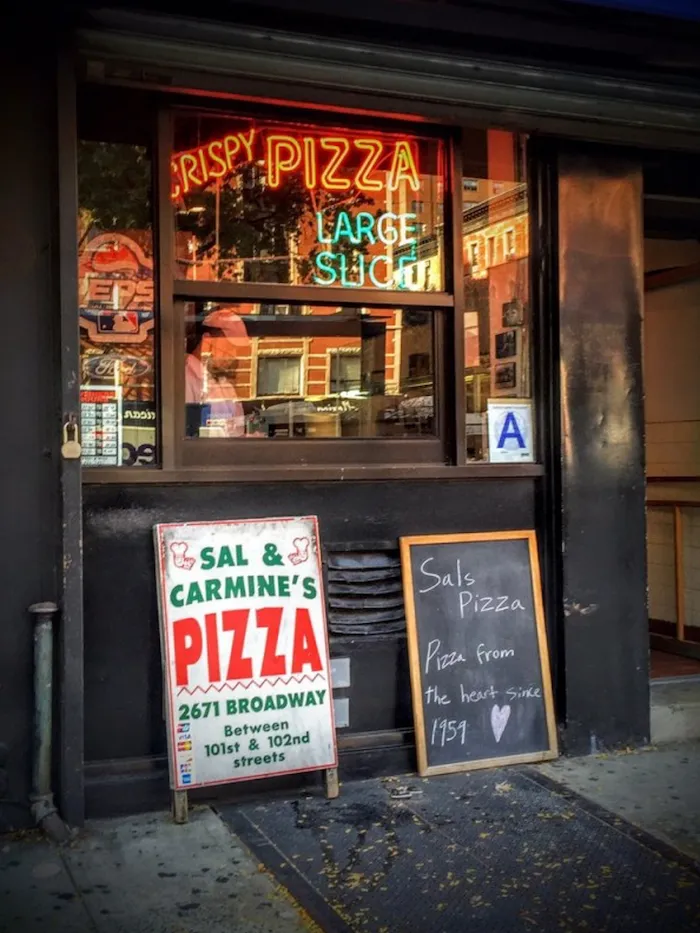
NYC pizzerias famously sell by the slice, so one doesn’t have to commit to a meal, making them well suited for NYC’s fast eat-and-go pace. A true democratic dining experience, you might typically find yourself savoring a slice at the counter shoulder-to-shoulder with a cop, a doorman, local shop clerk, parent with kids or Columbia college student. Pizzerias like this were ahead of the curve on the notion of “open kitchen,” and the entertainment value of “counter dining” that took hold in the 2000s. You can savor your slice watching the daredevil acrobatics of the pizza maker tossing, spinning, and catching the discus of dough behind his back – a front seat at a NYC eating experience. I am glad to report that ‘Sal and Carmine’s continues to serve one of the finest NYC style pizzas.
Starting with the mass migrations from Italy in the 1860s and then at the beginning of the 20th, Italians originally set up restaurants to serve fellow immigrants, but their popularity quickly grew exponentially. The fact that New York was the most important port of entry for immigrants explains the proliferation of Italian, and other world, cuisines. The famous “red sauce”, as well as other dishes, were tasty, affordable, and accessible.
When I was in my twenties, after our bi-weekly game of squash my father and I would go to V&Ts, a typical Italian eatery that has been serving up “red sauce” Italian dishes on Amsterdam Avenue and 110th street (across the street from the awe-inspiring Cathedral of Saint John the Devine). It wasn’t fine dining, but the food was hearty, the atmosphere spirited and unpretentious, and the neon window sign a throwback to the Manhattan out of the black and white movies.
Mexican: Fishbowl Sized Goblets & the Perennial Guacamole
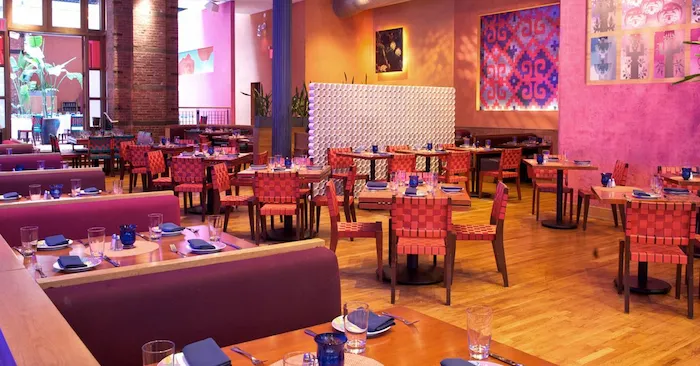
The evolution of NYC food has mirrored immigration and demographic trends. With the Hispanic population is expected to make up one third of the US by 2050, and Mexicans representing the largest single Hispanic group, it’s no wonder that Mexican (second after Chinese in popularity, according to Progressive Grocer Magazine) is the fastest growing world food category in the nation.
But demographics alone don’t account for its enormous success. I once asked NYC Chef-Restaurateur Julian Medina how one can explain the enormous success of Mexican food in NYC, and he pointed out that Mexican cuisine is flavorful, affordable, and lots of fun. I would venture a bet that you could find the word “fiesta” on more than half the Mexican restaurant menus. Mexican is especially popular with party groups and as an after-work watering hole where young men and women gather to unwind and enjoy Frozen Margheritas in fishbowl sized goblets accompanied by the ever popular dish of Guacamole.
The act of sharing this dish while enjoying fruity frozen cocktails sets a party like dynamic right away. Medina’s Toloache restaurant is representative of the more culinarily sophisticated version of the category where the food is the star. Dos Caminos and Rosa Mexicano are examples of the more “popular” Mexican, where the party atmosphere and fun drinks are the draw. Chef Danny Mena’s La Loncheria in Brooklyn is one of the more authentic Mexican featuring Mexico City inspired street food in a comfortably gritty setting, with a counter that feels part luncheonette, part bar, with cool gritty art painted onto the walls and tables. A vibe very at home in Brooklyn.
Bagels & Brines: Jewish deli/Eastern Europe
If one was to identify a single food category most widely associated with NYC, Jewish Deli food would be a safe bet. As the city with the second largest Jewish population (outside of Tel Aviv) foods with Eastern European Jewish origins have long since taken root in NYC. The original Jewish Delis are disappearing faster than print media.
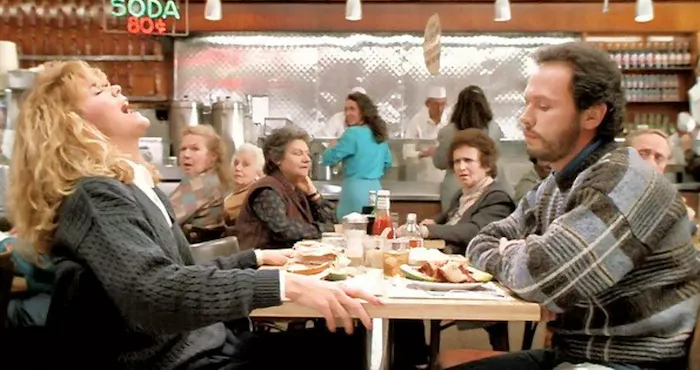
Operating since 1888 on the Lower East Side, the epicenter of the Jewish Immigration at the turn of the 20th Century, Katz’s Deli was a mainstay of the community, a place to gawk at the who’s-who of the vibrant Yiddish Theater scene thriving on Second Avenue at the time.
What brought Katz’s the greatest international fame, besides it’s food, is the hilarious scene in the Billy Crystal movie, “When Harry Met Sally,” where, after Meg Ryan simulates an orgasm at the table, the patron at the next table tells the waiter, “I’ll have whatever she’s having.” Katz’s legendary sandwiches are the Corned Beef and of Pastrami, deli meats of Romanian origin which are made from beef brisket that has been brined, dried, seasoned, then smoked and slow cooked.
The talented French chef-entrepreneur Moise Sfez told me that Katz’s was one of the Delis that inspired his hugely popular Paris eatery, Janet By Homer, which bears the slightly irreverent tag line, “Le nouveau temple du Corned Beef” (The new temple of Corned Beef). “I traveled to New York almost every year to experience this street food [from Eastern Europe] of Jewish Delis, I wanted to bring this to Paris.” He has. And it is an unqualified success.
My late college pal Elliott Goodman taught me the secret to getting an extra lean Pastrami sandwich. “It’s simple”, he said, “just slip the Deli man a two-dollar tip and tell him you want ‘the good stuff’.” Just as a French Bistro will have a basket of bread for the table, the real Jewish Delis, like the now defunct Second Avenue Deli, lavishly apportioned each table with bowls filled with tangy deli pickles and sweet crunchy homemade Cole Slaw, a shredded cabbage salad. A version of this Jewish Deli staple was enjoyed by the ancient Romans, throughout Europe, and was probably introduced to NYC by Manhattan’s Dutch settlers (Kool means Cabbage and Sla, salad.)
NYC Jewish food has also given rise to what may arguably be the most world-famous NYC baked good, the NYC Bagel. Brought to NYC by Polish Jewish immigrants, the bagel even had its own trade union in 1900. This boiled then baked bread’s signature hole made it easy to string together for transportation and storage. A bagel smeared with cream cheese and a slice of smoked Salmon is a NYC Brunch staple by which many brunch spots are judged, and has become a brunch staple throughout the world.
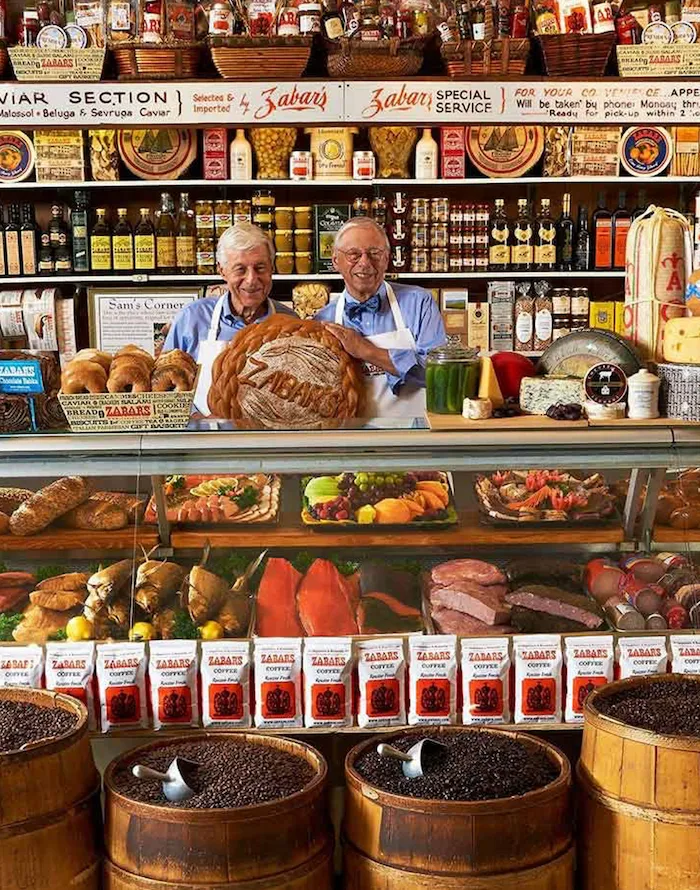
Bagels, smoked fish, corned beef, pastrami, knishes (baked dough with fillings), Babka (twisted poppy seed pastry), and a cornucopia of other Jewish inspired savory and sweet delights can be purchased at Zabar’s Market, NYC’s longest operating gourmet emporium, which still stands in its original location on Broadway and 85th street. When passing through town, ex-New Yorkers like me often make a pit-stop there for favorite Jewish gourmet goodies.
My personal must-have is the Rugelach (Yiddish for “little twist”) poppy, jam or chocolate filled thumb sized pastries that were invented around the same time in the late seventeenth century as the Croissant, which they somewhat resemble in miniature. (Bringing pastries back to Paris may be like bringing coal to Newcastle, but for the Rugelach I risk the scorn.)
Zabar’s Market is the anchor of a foodie Golden Triangle in the heart of Manhattan’s Upper West Side, where more affluent second and third generation Jews settled in the early Twentieth Century. Across the street from Zabar’s you might find yourself waiting in line next to a famous film director, opera diva or hungry New Yorker, mesmerized by the heady smell of baking dough in anticipation of hot-out-of-the oven bagels at (now relocated) H&H Bagels shop (the best in NYC in my opinion.)
Ten blocks south, on seventy-fourth and Broadway, still stands Fairway Market – the second point on the triangle – a grocery and gourmet paradise, open 24/7 (appropriate for foodies in the City that never sleeps). Former Fairway’s partner and head of purchasing, Steve Jenkins was one of the pioneers who I believe deserves credit for introducing, promoting, and popularizing gourmet cheeses, olive oils and many other specialty foods to the US. Traveling extensively through Europe (primarily France, Italy and Spain) to find specialty food products for all the Fairway Market locations, Jenkins met with artisan producers and discovered a world of fine foods. Through his passion and influence he moved the needle to advance the state of specialty food in NYC, and therefore the US at large.
The third point of the triangle is Barney Greengrass, the bustling Jewish Deli restaurant renowned its cornucopia of smoked and pickled fish, and where you will find saw dust covering the floors as it has since it opened in 1908. If food is a pillar of culture, and a lynchpin of living memory, then the Upper West Side, where I grew up, despite its relentless construction and development, affords some gastronomic portals to the past, without which I fear the city would risk losing its soul.
Greek: From ‘Lunch Wagons’ to Diners
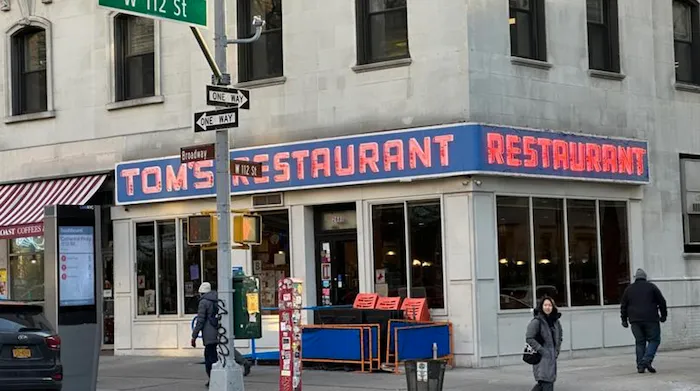
The American Diner began as late nineteenth Century Lunch Wagons, a precursor of the Food Truck, traveling on wheels to feed hungry workers. Lunch Wagons evolved into stationary eateries fashioned after railroad dining cars, which accounts for the train car like tube shape of the classic diner. Roadside diners popped up to sustain travelers crisscrossing America’s spreading highways. Diners have been captured in countless films (Buddy Can you Spare a Dime), television shows (Tom’s Diner by Columbia University was recreated in a studio as set for Seinfeld), and of course immortalized in Edward Hopper’s Nighthawk painting.
The classic Diner is a place where you can sit at one of the booths lining the window or on a stool at the counter running the length of the room as you enjoy your heaping plate of eggs (or pancakes), toast, hash brown potatoes washed down with a bottomless cup of coffee (free refills). When I was driving a limousine for extra money just out of college, I recall the limos filling the parking lots of Diners along the West Side Highway where we would stop to refuel ourselves after midnight. Some of the most classic diners were given a contemporary twist. My favorite go-to spot for 4 am breakfasts with friends after a night out was the Empire Diner, whose art deco interior of gleaming steel, mirrors and streamlined seating offered a wonderful contrast with the buzz of the glam-rock club kids, preppies and yuppies that enjoyed the eclectic menu. As a salute to the classic diners, they served up amazing hamburgers and milk shakes, two diner staples that have found their way across socioeconomic lines and across the globe.
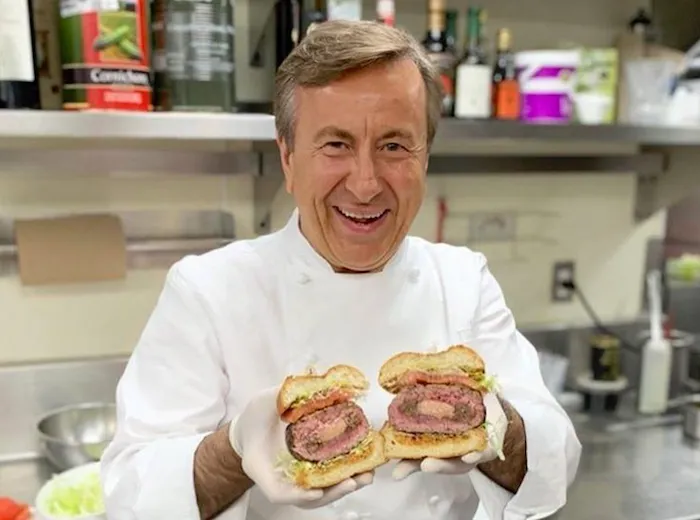
Burgers eventually became acceptable in upscale eateries, and in NYC it was in large part thanks to Michelin starred French chef, Daniel Boulud who created an uproar when he put a $40 hamburger on his menu. Hamburgers have grown into an entire restaurant category of their own. French food entrepreneur Jean Valfort told me that traveling in the US and experiencing what chefs and entrepreneurs were doing gave him his “aha” moment which led to Smash Burger, the first of his many popular Paris food concepts.
French: “Accessible French” was pretty much an oxymoron
As I’ve mentioned, France has had an immeasurable influence on cuisine in America, and NYC since the time of the American revolution. It’s significant that the training at American culinary schools is based on teaching “French Technique”. French cuisine in NYC has long dominated the world of upscale (or “white tablecloth”) restaurants in NYC. Michelin starred French Chefs David Boulud and Jean-Georges Vongerichten (forty-two restaurants across fifteen countries), are arguably NYC’s most successful French Chef-restaurateurs.
I would attribute the fantastic success of French chefs I have known and worked with in part to the confluence of two attributes: A European culinary sensibility combined with an ambitious entrepreneurial spirit (the kind so encouraged in the US). French cuisine has also been advanced in NYC by legions of non-French chefs. Among those was Chef Anthony Bourdain, who was not yet a celebrity when I began managing his public relations. From our first meeting I was struck by his boundless passion for French cuisine, which he had studied at the prestigious Culinary Institute of America. In fact, he jumped at the idea of co-authoring (with Brasserie Les Halles partner Jose de Meirelles) the Les Halles Cookbook of French cuisine which I pitched to Bloomsbury publishing.
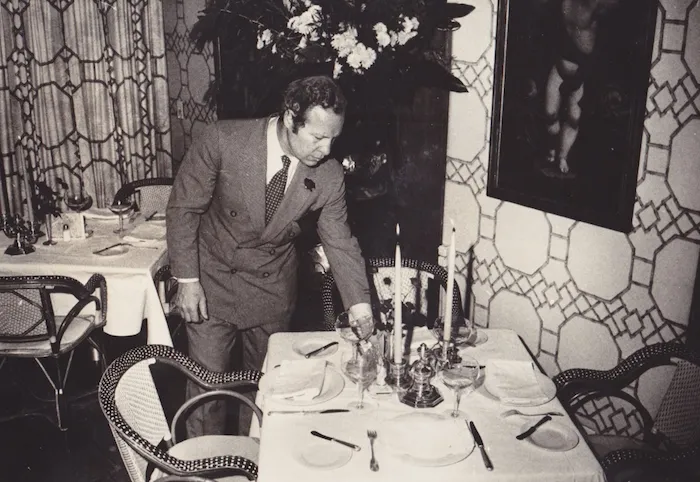
When I was growing up French restaurants were relegated to very, very special occasions, and the closest most people got to a look behind the gilded doors were photos of the bold face names, heads of state and movie stars seen eating at them in the magazine and newspaper society pages. My NYC wedding dinner was held at Chef Andre Soltner’s world famous Lutece in Midtown Manhattan. (Soltner would eventually dedicate himself to teaching at the NYC based French Culinary Institute, which has produced a staggering number of celebrity chefs.) “Accessible French” was pretty much an oxymoron. That changed after September eleventh, 2001. The attack on NYC’s Twin Towers brought the restaurant industry to a halt (not unlike the Covid confinement).
For the next two years, nervous New Yorkers wary of venturing far for dinner, stayed close to home and neighborhood restaurants thrived. Destination restaurants, which included many upscale and French suffered, went out business or moved. As during the Pandemic many restaurants managed to pivot their business models on the basic business principle of lower price to increase demand. The city saw several classic French favorites add more accessible café or Bistro versions of their brands. The result was not only a proliferation of affordable French options, but a sea change in diners’ perception of French food, and arguably all things French.
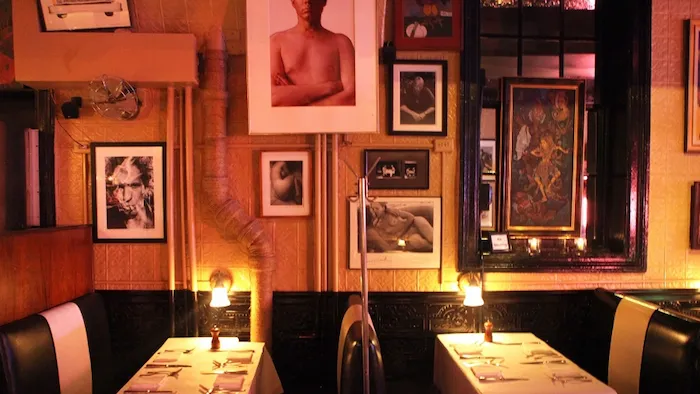
At the tail end of the twentieth century restaurants from the land of Lafayette not only became more user-friendly, they became outright cool. Two of the hottest downtown nightlife and dining destinations in the excess-filled nineteen eighties (both of which continue to operate) were French concepts that appealed to the sense of nostalgia and a growing reverence for France. Raoul’s continues to promote itself as having “a bustling Parisian atmosphere & a serious French menu,” while Odeon, a reproduction of a classic French Brasserie, was the place where movers-and-shakers from the literary, music, and art worlds as well as the titans of Wall Street mingled until dawn.
Ingredients in the Melting Pot: NY Street Food
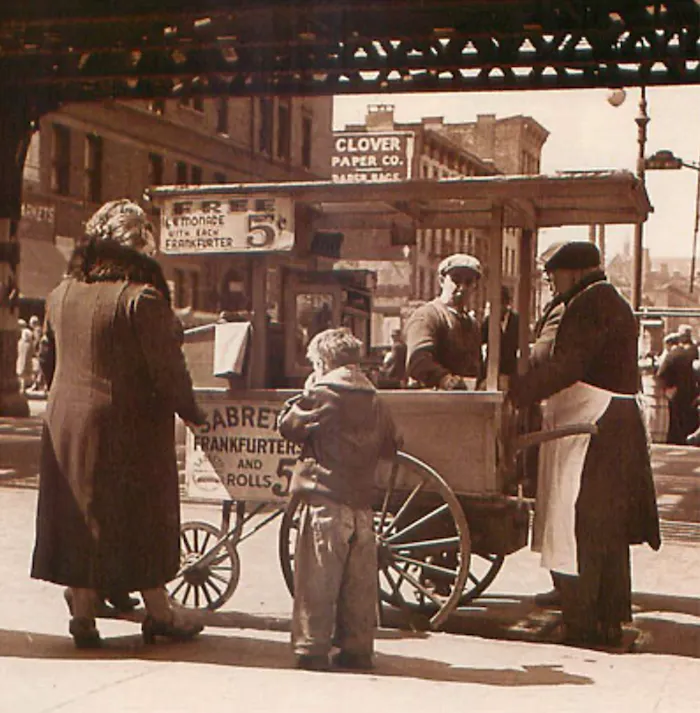
While the Melting Pot that is NYC may enjoy one of the most culturally diverse food landscapes, it cannot boast a particularly robust array of street food. The ubiquitous Hot Dog is probably the closest thing to a real NYC street food experience. New Yorker’s (wisely) prefer to avoid examining the actual provenance, production, or ingredients too closely, but rather to enjoy the always satisfying street treat. World renowned and praised by many, it’s been posted on social media being devoured by celebrities such as George Clooney, Andy Warhol, Barak Obama, and Lady Gaga. The NYC Weiner is arguably the most democratizing dish.
Perhaps the image that best sums up the world of New York food that I grew up with is standing in line in front of a Sabrett Hot Dog stand with a horde of hungry New Yorkers, in suits or sweats, possibly coming from a gala, a rock concert, disco, theater or late shift, Chief Executive or clerk. All waiting patiently together to enjoy a Frankfurter nestled in a bun and smothered with mustard and relish. We may have all been ingredients in the “Melting Pot” of NYC, but we were also guests at the feast.


